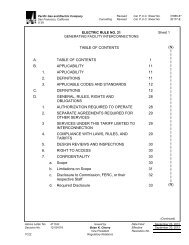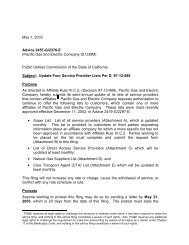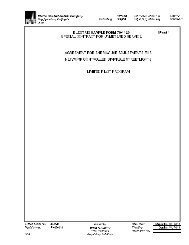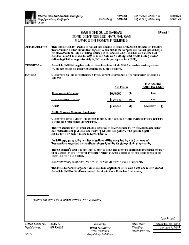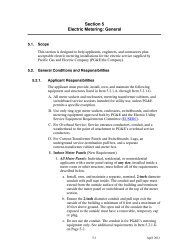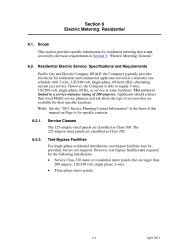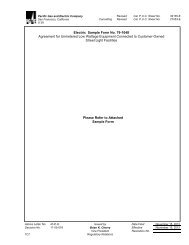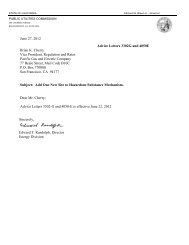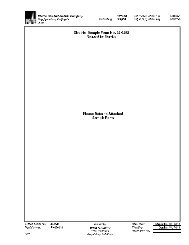2010 FERC Form 1 - Pacific Gas and Electric Company
2010 FERC Form 1 - Pacific Gas and Electric Company
2010 FERC Form 1 - Pacific Gas and Electric Company
You also want an ePaper? Increase the reach of your titles
YUMPU automatically turns print PDFs into web optimized ePapers that Google loves.
Name of Respondent<br />
PACIFIC GAS AND ELECTRIC COMPANY<br />
This Report is:<br />
(1) X An Original<br />
(2) A Resubmission<br />
Date of Report<br />
(Mo, Da, Yr)<br />
04/08/2011<br />
Year/Period of Report<br />
<strong>2010</strong>/Q4<br />
NOTES TO FINANCIAL STATEMENTS (Continued)<br />
industry sectors in the U.S. <strong>and</strong> other regions of the world. Equity securities are generally valued based on unadjusted prices in active<br />
markets for identical transactions <strong>and</strong> are classified as Level 1.<br />
Debt securities are comprised primarily of fixed income securities that include U.S. government <strong>and</strong> agency securities,<br />
municipal securities, <strong>and</strong> corporate debt securities. A market based valuation approach is generally used to estimate the fair value of<br />
debt securities classified as Level 2 instruments in the tables above. Under a market approach, fair values are determined based on<br />
evaluated pricing data, such as broker quotes, for similar securities adjusted for observable differences. Significant inputs used in the<br />
valuation model generally include benchmark yield curves <strong>and</strong> issuer spreads. The external credit rating, coupon rate, <strong>and</strong> maturity of<br />
each security are considered in the valuation, as applicable.<br />
The Consolidated Balance Sheets of PG&E Corporation <strong>and</strong> the Utility contain assets held in trust for the PG&E Retirement<br />
Plan Master Trust, the Postretirement Life Insurance Trust, <strong>and</strong> the Postretirement Medical Trusts presented on a net basis. (See Note<br />
12 below.) The pension assets are presented net of pension obligations as noncurrent liabilities – other in PG&E Corporation’s <strong>and</strong> the<br />
Utility’s Consolidated Balance Sheets.<br />
Price Risk Management Instruments<br />
Price risk management instruments include physical <strong>and</strong> financial derivative contracts, such as futures, forwards, swaps,<br />
options, <strong>and</strong> CRRs that are either exchange-traded or over-the-counter traded. (See Note 10 above.)<br />
Futures, forwards, <strong>and</strong> swaps are valued using observable market prices for the underlying commodity or an identical<br />
instrument <strong>and</strong> are classified as Level 1 or Level 2 instruments. For periods where market data is not available, the Utility extrapolates<br />
forward prices. Other futures, forwards, <strong>and</strong> swaps are considered Level 3 instruments as the determination of their fair value includes<br />
the use of unobservable forward prices.<br />
All energy-related options are classified as Level 3 <strong>and</strong> are valued using a st<strong>and</strong>ard option pricing model with various<br />
assumptions, including forward prices for the underlying commodity, time value at a risk free rate, <strong>and</strong> volatility. For periods when<br />
market data is not available, the Utility extrapolates these assumptions using internal models.<br />
The Utility holds CRRs to hedge financial risk of CAISO-imposed congestion charges in the day-ahead markets. CRRs are<br />
valued based on the forecasted settlement price at the delivery points underlying the CRR using internal models. The Utility also uses<br />
the most current annual auction prices published by the CAISO to calibrate internal models. Limited market data is available between<br />
auction dates; therefore, CRRs are classified as Level 3 measurements.<br />
The Utility enters into power purchase agreements for the purchase of electricity to meet the dem<strong>and</strong> of its customers. (See<br />
Note 10 above.) The Utility uses internal models to determine the fair value of these power purchase agreements. These power<br />
purchase agreements include contract terms that extend beyond a period for which an active market exists. The Utility utilizes market<br />
data for the underlying commodity to the extent that it is available in determining the fair value. For periods where market data is not<br />
available, the Utility extrapolates forward prices. These power purchase agreements are considered Level 3 instruments as the<br />
determination of their fair value includes the use of unobservable forward prices.<br />
Transfers between Levels<br />
PG&E Corporation <strong>and</strong> the Utility recognize any transfers between levels in the fair value hierarchy as of the end of the<br />
reporting period. There were no significant transfers between levels for the year ended December 31, <strong>2010</strong>.<br />
Level 3 Reconciliation<br />
The following tables present reconciliations for assets <strong>and</strong> liabilities measured <strong>and</strong> recorded at fair value on a recurring basis,<br />
using significant unobservable inputs (Level 3), for the years ended December 31, <strong>2010</strong> <strong>and</strong> 2009:<br />
PG&E Corporation Only<br />
PG&E Corporation <strong>and</strong> the Utility<br />
<strong>FERC</strong> FORM NO. 1 (ED. 12-88) Page 123.35



